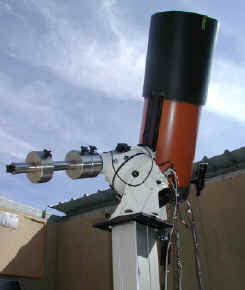One of the most exciting aspects of the exoplanet hunt is that it is not confined to huge telescopes and professional astronomers. Timothy Ferris described the remarkable advances in amateur equipment and observing techniques in Seeing In the Dark (Simon & Schuster, 2002), but he’ll need a whole new chapter to cover what’s happening not only with distributed computing (as via the systemic collaboration, for example) and the software and hardware advances that let amateurs observe exoplanet transits from sites around the world.

Last night Tonny Vanmunster observed the transiting ‘hot Neptune’ GJ 436 b from his CBA Belgium Observatory in Landen, reporting his results over the Net and this morning on his Web site. Ponder this: GJ 436 b orbits an M-class red dwarf that is 33 light years away. The planet itself has a mass roughly 23 times that of Earth, with a radius approximately that of Neptune. There was a time when Neptune itself would have been a tricky catch for the average amateur, but we’re entering the era of the amateur as exoplanet specialist. GJ 436 b is the sixth transiting exoplanet Vanmunster has bagged from his pastoral observatory.
Image: One of Vanmunster’s instruments. This is a 0.35-m f/6.3 telescope mounted on Astro-Physics AP1200-GTO mount. SBIG ST-7XME CCD camera. Credit: Tonny Vanmunster.
Here’s the gist of his report. Check the site for the actual light curve for the transit, doubtless the first made by an amateur:
Rather unexpectedly, the skies cleared out on May 17/18, 2007 over CBA Belgium Observatory, shortly before the start of a transit of exoplanet GJ 436 b. Photometric conditions were not ideal (bit of haze), but I started a photometry session using a 0.35-m f/6.3 telescope and SBIG ST-7XME CCD camera with V filter. ..
The times of predicted ingress and egress are indicated (taken from Transitsearch.org). The actual transit started a bit later than predicted and its duration was also a bit shorter than predicted. This is in agreement with the fact that the Transitsearch.org prediction was made for a central transit, which is not the case for GJ 436 b.

Image: CBA Belgium Observatory is located in Flanders, Belgium. It is a remotely controlled observatory, that can be operated autonomously all night long. The only human interaction required is for opening and closing of the observatory, and initialisation of the telescopes, CCD cameras and computers. The building has a roll-off roof structure, and is measuring 3m by 4m. Credit: Tonny Vanmunster.
It could be argued, of course, that Vanmunster is not your average amateur. His observatory is the Belgian node for a network of amateur and professional astronomers known as the Center for Backyard Astrophysics, and his exoplanet observations go to the XO Project as well as Transitsearch.org. He’s also the author of Peranso, a software package designed for light curve analysis, so it’s no surprise that he was the first amateur to detect the transits of TrES-1b, TrES-2b and co-discoverer of XO-1b.
But it fires the imagination to think that a small observatory using two Celestron Schmidt-Cassegrain telescopes for CCD photometry and armed with laptop computers and a wireless network can be contributing serious scientific data to one of the most advanced investigations of our time. The opportunities for non-professionals to contribute meaningfully to the exoplanet hunt should engage a new generation of researchers, with or without academic affiliation. What counts are the data, and the data are obtainable, as the work of Tonny Vanmunster continues to demonstrate.


TRUFAS, a wavelet based algorithm for the rapid detection of planetary transits
Authors: C. Regulo (1,2), M. Almenara (1), R. Alonso (3), H.J. Deeg (1), T. Roca Cortes (1,2) ((1) IAC, (2) U. La Laguna, (3) LAM)
(Submitted on 31 May 2007)
Abstract: Aims: We describe a fast, robust and automatic detection algorithm, TRUFAS, and apply it to data that are being expected from the CoRoT mission. Methods: The procedure proposed for the detection of planetary transits in light curves works in two steps: 1) a continuous wavelet transformation of the detrended light curve with posterior selection of the optimum scale for transit detection, and 2) a period search in that selected wavelet transformation. The detrending of the light curves are based on Fourier filtering or a discrete wavelet transformation. TRUFAS requires the presence of at least 3 transit events in the data. Results: The proposed algorithm is shown to identify reliably and quickly the transits that had been included in a standard set of 999 light curves that simulate CoRoT data. Variations in the pre-processing of the light curves and in the selection of the scale of the wavelet transform have only little effect on TRUFAS’ results. Conclusions: TRUFAS is a robust and quick transit detection algorithm, especially well suited for the analysis of very large volumes of data from space or ground-based experiments, with long enough durations for the target-planets to produce multiple transit events.
Comments: 9 pages, 10 figures, accepted by A&A
Subjects: Astrophysics (astro-ph)
Cite as: arXiv:0705.4557v1 [astro-ph]
Submission history
From: Hans J. Deeg [view email]
[v1] Thu, 31 May 2007 10:26:51 GMT (431kb)
http://arxiv.org/abs/0705.4557
Accurate Spitzer infrared radius measurement for the hot Neptune GJ 436b
Authors: M. Gillon (1, 2), B.-O. Demory (1), T. Barman (3), X. Bonfils (4), T. Mazeh (5), S. Udry (1), M. Mayor (1), D. Queloz (1) ((1) Observatoire de l’Universite de Geneve, Sauverny, Switzerland, (2) Institut d’Astrophysique et de Geophysique, Universite de Liege, Liege, Belgium, (3) Lowell Observatory, Flagstaff, USA, (4) Observatorio Astronomico de Lisboa, Lisboa, Portugal, (5) School of Physics and Astronomy, Raymond and Beverly Sackler Faculty of Exact Sciences, Tel Aviv University, Tel Aviv, Israel)
(Submitted on 16 Jul 2007 (v1), last revised 16 Jul 2007 (this version, v2))
Abstract: We present Spitzer Space Telescope infrared photometry of a primary transit of the hot Neptune GJ 436b. The observations were obtained using the 8 microns band of the InfraRed Array Camera (IRAC). The high accuracy of the transit data and the weak limb-darkening in the 8 microns IRAC band allow us to derive (assuming M = 0.44 +- 0.04 Msun for the primary) a precise value for the planetary radius (4.19 +0.21-0.16 Rearth), the stellar radius (0.463 +0.022-0.017 Rsun), the orbital inclination (85.90 +0.19-0.18 degrees) and transit timing (2454280.78186 +0.00015-0.00008 HJD). Assuming current planet models, an internal structure similar to that of Neptune with a small H/He envelope is necessary to account for the measured radius of GJ 436b.
Comments: Submitted; 5 pages, 3 figures
Subjects: Astrophysics (astro-ph)
Cite as: arXiv:0707.2261v2 [astro-ph]
Submission history
From: Michael Gillon [view email]
[v1] Mon, 16 Jul 2007 18:27:36 GMT (49kb)
[v2] Mon, 16 Jul 2007 21:47:56 GMT (49kb)
http://arxiv.org/abs/0707.2261
The transiting exoplanet host star GJ 436: a test of stellar evolution models in the lower main sequence, and revised planetary parameters
Authors: Guillermo Torres (Harvard-Smithsonian Center for Astrophysics)
(Submitted on 25 Oct 2007)
Abstract: Knowledge of the stellar parameters for the parent stars of transiting exoplanets is pre-requisite for establishing the planet properties themselves, and often relies on stellar evolution models. GJ 436, which is orbited by a transiting Neptune-mass object, presents a difficult case because it is an M dwarf. Stellar models in this mass regime are not as reliable as for higher mass stars, and tend to underestimate the radius. Here we use constraints from published transit light curve solutions for GJ 436 along with other spectroscopic quantities to show how the models can still be used to infer the mass and radius accurately, and at the same time allow the radius discrepancy to be estimated. Similar systems should be found during the upcoming Kepler mission, and could provide in this way valuable constraints to stellar evolution models in the lower main sequence. The stellar mass and radius of GJ 436 are M = 0.452 [-0.012,+0.014] M(Sun) and R = 0.464 [-0.011,+0.009] R(Sun), and the radius is 10% larger than predicted by the standard models, in agreement with previous results from well studied double-lined eclipsing binaries. We obtain an improved planet mass and radius of M = 23.17 +/- 0.79 M(Earth) and R = 4.22 [-0.10,+0.09] R(Earth), a density of rho = 1.69 [-0.12,+0.14] g/cm3, and an orbital semimajor axis of a = 0.02872 +/- 0.00027 AU.
Comments: Accepted for publication in The Astrophysical Journal Letters, 5 pages including figures and tables, in emulateapj format
Subjects: Astrophysics (astro-ph)
Cite as: arXiv:0710.4883v1 [astro-ph]
Submission history
From: Guillermo Torres [view email]
[v1] Thu, 25 Oct 2007 15:00:30 GMT (95kb)
http://arxiv.org/abs/0710.4883
On the Apparent Orbital Inclination Change of the Extrasolar Transiting Planet TrES-2b
Authors: Louis J. Scuderi, Jason A. Dittmann, Jared R. Males, Elizabeth M. Green, Laird M. Close
(Submitted on 9 Jul 2009)
Abstract: On June 15, 2009 UT the transit of TrES-2b was detected using the University of Arizona’s 1.55 meter Kuiper Telescope with 2.0-2.5 millimag RMS accuracy in the I-band. We find a central transit time of T_c = 2454997.76286 +/- 0.00035 HJD, an orbital period of P = 2.4706127 +/- 0.0000009 days, and an inclination angle of i = 83.92 +/- 0.05 degrees, which is consistent with our re-fit of the original I-band light curve of O’Donovan et al. (2006) where we find i = 83.84 +/- 0.05 degrees.
We calculate an inclination change of Delta i = -0.08 +/- 0.071 degrees over the last 3 years, and as such, our observations rule out, at the ~11 sigma level, the apparent change of orbital inclination to i_predicted = 83.35 +/- 0.1 degrees as predicted by Mislis & Schmitt (2009) for our epoch. Indeed, we detect no significant changes in any of the orbital parameters of TrES-2b when comparing the original I-band light curve to our recent I-band light curve.
Comments: 15 pages, 1 table, 5 figures. Submitted to ApJ, July 8, 2009
Subjects: Earth and Planetary Astrophysics (astro-ph.EP)
Cite as: arXiv:0907.1685v1 [astro-ph.EP]
Submission history
From: Louis Scuderi Mr. [view email]
[v1] Thu, 9 Jul 2009 21:44:20 GMT (723kb)
http://arxiv.org/abs/0907.1685